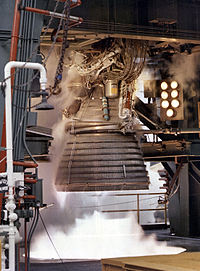J-2S

J-2 test firing.
|
|
| Country of origin | United States |
|---|---|
| First flight | 26 February 1966 (AS-201) |
| Last flight | 15 July 1975 (ASTP) |
| Designer | MSFC/Rocketdyne |
| Manufacturer | Rocketdyne |
| Application | Upper stage engine |
| Associated L/V |
Saturn IB (S-IVB) Saturn V (S-II and S-IVB) |
| Successor |
HG-3 J-2X |
| Status | Retired |
| Liquid-fuel engine | |
| Propellant | Liquid oxygen / Liquid hydrogen |
| Mixture ratio | 5.5:1 |
| Cycle | Gas generator |
| Configuration | |
| Nozzle ratio | 27.5:1 |
| Performance | |
| Thrust (vac.) | 1,033.1 kN (232,250 lbf) |
| Thrust (SL) | 486.2 kN (109,302 lbf) |
| Thrust-to-weight ratio | 73.18 |
| Chamber pressure | 5,260 kilopascals (763 psi) |
| Isp (vac.) | 421 seconds (4.13 km/s) |
| Isp (SL) | 200 seconds (2.0 km/s) |
| Burn time | 500 seconds |
| Dimensions | |
| Length | 3.4 metres (11.1 ft) |
| Diameter | 2.1 metres (6.8 ft) |
| Dry weight | 1,788.1 kilograms (3,942 lb) |
| References | |
| References | |
| Notes | Data is for SA-208/SA-504 version. |
The J-2 was a liquid-fuel cryogenic rocket engine used on NASA's Saturn IB and Saturn V launch vehicles. Built in the U.S. by Rocketdyne, the J-2 burned cryogenic liquid hydrogen (LH2) and liquid oxygen (LOX) propellants, with each engine producing 1,033.1 kN (232,250 lbf) of thrust in vacuum. The engine's preliminary design dates back to recommendations of the 1959 Silverstein Committee. Rocketdyne won approval to develop the J-2 in June 1960 and the first flight, AS-201, occurred on 26 February 1966. The J-2 underwent several minor upgrades over its operational history to improve the engine's performance, with two major upgrade programs, the de Laval nozzle-type J-2S and aerospike-type J-2T, which were cancelled after the conclusion of the Apollo program.
The engine produced a specific impulse (Isp) of 421 seconds (4.13 km/s) in a vacuum (or 200 seconds (2.0 km/s) at sea level) and had a mass of approximately 1,788 kilograms (3,942 lb). Five J-2 engines were used on the Saturn V's S-II second stage, and one J-2 was used on the S-IVB upper stage used on both the Saturn IB and Saturn V. Proposals also existed to use various numbers of J-2 engines in the upper stages of an even larger rocket, the planned Nova. The J-2 was America's largest production LH2-fuelled rocket engine before the RS-25 Space Shuttle Main Engine. A modernized version of the engine, the J-2X, was considered for use on the Earth Departure Stage of NASA's Space Shuttle replacement, the Space Launch System.
...
Wikipedia
